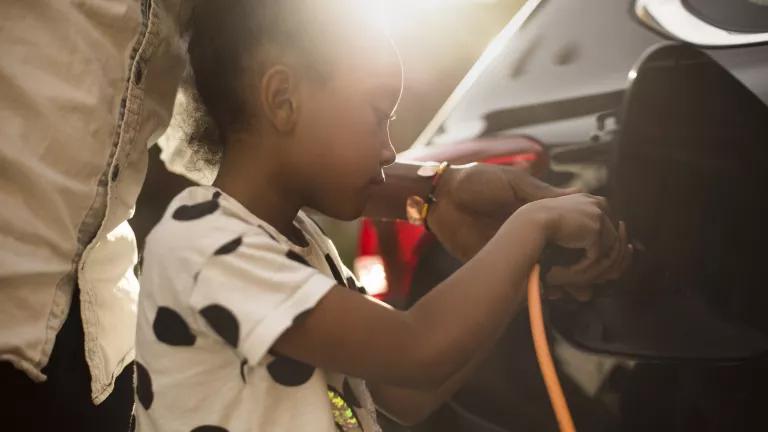New York City’s Landmark Congestion Pricing Program Hits New Roadblock
NRDC will continue working with groups to bring back congestion pricing, which can benefit low-income residents and workers.

Costly and polluting vehicle traffic will continue, and public transit will crater without congestion pricing.
Marc A. Hermann/MTA
Congestion pricing—the transformative strategy that would inject massive new funds into the nation’s largest transit system, untangle congestion in Manhattan’s traffic-plagued central business district, and slice car and truck air pollution emissions—has hit an eleventh hour roadblock.
Governor Kathy Hochul has directed New York City’s regional public transit agency, the Metropolitan Transportation Authority (MTA), “to indefinitely pause the program,” which had been scheduled to go into effect beginning June 30.
The governor’s surprising and shattering announcement has created a fiscal earthquake that leaves a gaping hole in the MTA’s capital budget and jeopardizes the system’s ability to deliver safe and reliable transit service to millions of daily transit riders.
The congestion pricing program would charge auto drivers entering Manhattan at or below 60th Street a $15 toll during peak periods and $3.75 during overnight hours. Trucks would pay $24 to $36 during peak periods and $6 to $9 overnight. The program would also offer reduced rates to vehicles entering the district from one of four already tolled tunnels and a discount plan for qualifying low-income drivers.
Congestion pricing in one form or another has been part of NYC’s transit and clean air policy discussions since the 1970s. And similar programs have been operating successfully in London, Singapore, and Stockholm for years.
The MTA projected that the New York tolling program would generate about $1 billion a year, which would be used to secure $15 billion in much-needed capital improvements to the region’s subway, bus, and commuter rail network. According to the transit agency, congestion pricing would also cut an estimated 100,000 vehicles from entering the zone every day. This would speed the movement of emergency vehicles and those who must drive in what is now one of the most congested business districts in the country, where speeds have slowed to historic levels in recent years. Motor vehicle emissions would also be reduced—directly from smoother-moving traffic and indirectly as improved subway, bus, and rail service keeps transit ridership growing.
Among the many critical MTA capital projects that will now be caught in limbo are: the Second Avenue subway extension; signal system and subway station upgrades; new elevators and escalators to increase accessibility; security and safety improvements; new electric buses; and hundreds of millions of dollars of enhancements to the Long Island Rail Road and Metro-North Railroad.
At the top of the list of those likely to be harmed by the delay are the city’s low-income commuters. The Community Service Society, the distinguished anti-poverty nonprofit, analyzed the impact of congestion pricing on low-income New Yorkers. It found that only 2% of outer borough residents with incomes below the federal poverty line regularly commuted into the central business district in by private vehicle; most outer borough low-income residents relied instead on public transportation and would be well-served by congestion pricing.

License-plate reading equipment is ready, but congestion pricing strategy is stalled, jeopardizing the future of the region’s transit system.
Eric A. Goldstein/NRDC
One can hope that the governor’s directive will result in only a temporary setback and perhaps some minor adjustments in the pricing scheme. An extended delay of an infusion of capital funds would have a devastating long-term impact on a system that is the region’s transportation lifeline.
Meanwhile, questions are being raised as to whether the governor has the unilateral authority to block implementation of the congestion pricing program in the first place.
Columbia University law professor Michael Gerrard, one of the state’s most respected environmental legal scholars, raised exactly this point in a post on X. He noted that the New York State law creating the congestion pricing program directs that the MTA Bridges & Tunnels (an MTA affiliate) “shall establish” the tolling program. This suggests that the governor’s move could face a legal challenge unless it is authorized by action of the state legislature.
NRDC, which has advocated for implementation of the congestion pricing program and similar strategies for decades, will be working with a diverse coalition of environmental groups, transit activists, business leaders, and elected officials to get congestion pricing back on track.
One thing is for certain: The MTA’s fiscal ship, which faced headwinds even before this week, has just been socked with a Category 5 hurricane that threatens its survival. And Governor Hochul now owns the problem.
This blog provides general information, not legal advice. If you need legal help, please consult a lawyer in your state.

.jpg.jpg?h=44b879e5&itok=Mrg2EnX5)

